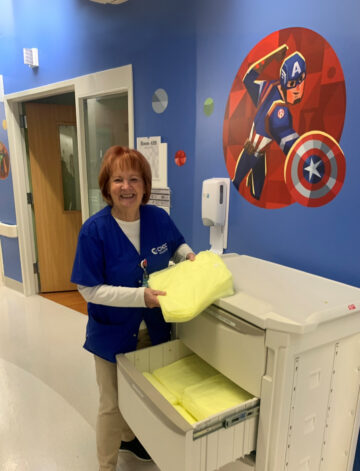How to reduce children’s fear of medical procedures
While we always want to be honest with children, sometimes some small language shifts can help reduce fear around medical procedures and routines, injuries and more.
This type of language is called “soft language,” and it’s employed by child life specialists at CHOC as one of many techniques to help normalize the hospital experience for children.
“Our goal is to use language that is still accurate and honest, but is less frightening,” says Christy Campo, manager of the Cherese Mari Laulhere Child Life Department at CHOC. “We want to build trust in healthcare experiences without causing extra anxiety.”
But soft language doesn’t have to be limited to just medical professionals. Parents and caregivers can also employ it to help navigate conversations with children about doctor’s visits, medical stays and more.
Here are seven situations wherein parents can employ simple language tweaks to help kids cope:
When getting an immunization: Instead of “shot,” consider “poke.”
Unfortunately, hearing “shot” might prompt images or fear of gun violence. It also may inadvertently make the pain level of an immunization sound worse than it is.
“Poke” is a good alternative because it’s more friendly language and a much more accurate statement of an immunization’s pain level.
When treating a cut: Instead of “staples,” consider “silver bandages.”
Suffering a cut that requires medical attention is scary and painful enough, but a term like “staples” will only escalate a child’s fear.
Try describing the treatment in a more neutral, accessible and friendly way, such as “silver bandages.” Instead of “stiches,” try “string bandages.”
When getting blood pressure measured: Instead of “blood pressure,” consider “arm hug” or “arm squeeze.”
Taking vitals like blood pressure is part of any well check or medical visit, so why not try to make it as easy as possible? Because children are so literal, when they hear “blood pressure,” they might think the exam involves bleeding and the word “pressure” might imply a painful squeeze.
Instead, try a term like “arm hug.” This in an accurate and softer description of what happens during this routine exam.
When getting blood taken: Instead of “tourniquet,” say “big rubber band.”
Having blood taken is scary enough for kids – and many adults! Let’s not escalate the situation by using a big word like “tourniquet,” when describing prep work to make veins more prominent.
At best, the child won’t know what this means – which could cause fear itself – and at worst, it may conjure images of bodily injury, blood loss and more. Instead, try describing the tourniquet as exactly what it is, a “big rubber band.”
Additionally, avoid saying “blood draw.” This may confuse children, who are often very literal and may think this means a drawing of blood. Instead, try being very descriptive: “They are going to take a little bit of blood from your arm.”
When getting anesthesia: Instead of “put you to sleep,” consider “napping medicine.”
A child who has lost a beloved pet might understandably balk at hearing undergoing anesthesia described as being “put to sleep.” Parents instead can explain it as “napping medicine” or “sleeping medicine” that a doctor gives.
Reassure them they will not feel anything and will not wake up until the doctor stops giving the sleeping medicine. This accurately describes that the period of “sleep” is temporary.
When getting bandages changed: Instead of “dress change” or “dressing change,” consider “clean, new bandages.”
Children might not understand what a dressing is and hearing this may unnecessarily cause worry or embarrassment that they’ll need to get undressed. Instead, explain exactly what is happening: they are getting new clean bandages.
When lying down to be moved in the hospital: Instead of “stretcher,” consider “bed on wheels.”
At best, “stretcher” could be confusing for a child and at worst, it may provoke images of medieval punishment. “Bed on wheels” is much more accurate and much less scary.
Learn more about CHOC’s specialized therapeutic programs
The Cherese Mari Laulhere Child Life Department at CHOC strives to normalize the hospital environment for patients and families.





